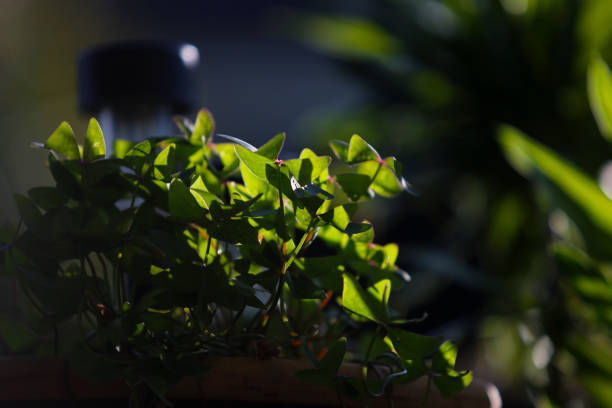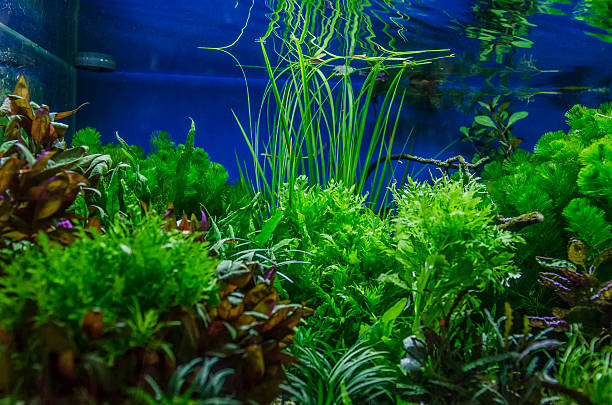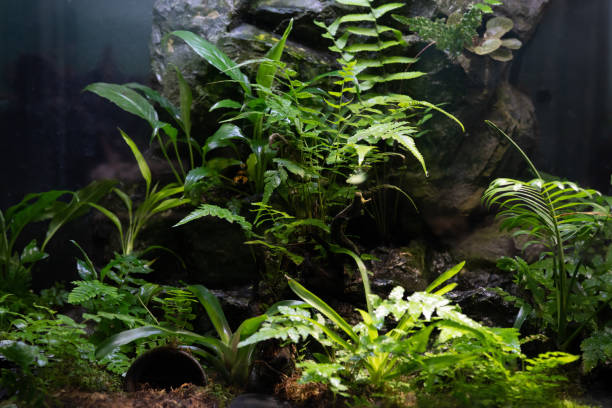Introduction to Black Goldfish Plant
The black goldfish plant, known scientifically as Nematanthus wettsteinii, is a captivating houseplant that is cherished for its unique appearance and charming blooms. This exotic plant, often referred to as the goldfish plant, gets its name from its vibrant, pouch-like flowers that resemble tiny goldfish.
As a member of the Gesneriaceae family, the black goldfish plant shares its lineage with other popular houseplants such as African violets and lipstick plants. Native to the tropical regions of Brazil, the black goldfish plant thrives in environments that mimic its natural habitat, making it an attractive yet manageable option for indoor gardening enthusiasts.
One of the key features that set the black goldfish plant apart is its striking dark green foliage, which provides a stunning contrast to its bright orange or red blooms. These flowers typically emerge during the spring and summer months, adding a splash of color and vibrancy to your indoor garden. Growing and caring for a black goldfish plant can be a rewarding experience for both novice and experienced gardeners.
With the right conditions, including proper light, water, and humidity, this plant can flourish and bring years of enjoyment. Understanding the basics of black goldfish plant care is essential to promote healthy growth and blooming. Whether you’re looking to add a new plant to your collection or enhance your indoor space, the black goldfish plant is a fantastic choice that combines aesthetic appeal with relative ease of care.
Taxonomy and Botanical Information
The Black Goldfish Plant, known scientifically as Nematanthus wettsteinii, is an exotic houseplant celebrated for its vibrant, ornamental appeal. This plant belongs to the Gesneriaceae family, which encompasses a variety of flowering plants commonly found in tropical regions.
Within the botanical hierarchy, it falls under the order Lamiales, which includes mint, verbena, and olive families. The genus Nematanthus is distinguished by its unique flower shapes and bright colors, reminiscent of tiny goldfish, thereby attributing to its common name. The Black Goldfish Plant is closely related to other members of the Nematanthus genus, exhibiting similar growth patterns and floral characteristics. In terms of morphology, the species nematanthus wettsteinii features thick, shiny, green leaves and vibrant orange or yellow pouch-like flowers.
These black-hued blooms give the plant its distinct name and make it an attractive addition to any indoor garden setting. Given its tropical origin, the Black Goldfish Plant thrives in warm, humid environments, making it well-suited for indoor cultivation. Understanding the taxonomy and botanical background of the Black Goldfish Plant helps in identifying its specific care requirements, thereby promoting healthier growth and abundant flowering.
In summary, the Black Goldfish Plant is not only an appealing houseplant but also a fascinating specimen within the Gesneriaceae family, contributing both beauty and botanical interest to indoor gardening enthusiasts.

Plant Attributes
The black goldfish plant is known for its striking appearance and unique floral characteristics. Its botanical name is Nematanthus wettsteinii and it belongs to the Gesneriaceae family. This tropical houseplant is prized for its glossy, dark green leaves and bright, tubular flowers that resemble small goldfish, hence the name.
One of the most distinctive features of the black goldfish plant is its vibrant orange or reddish-orange flowers. These flowers have a unique pouch-like shape, adding an exotic touch to indoor gardens. The black goldfish plant blooms primarily in the spring and summer months, making it a popular choice for adding color during these seasons.
In terms of foliage, the leaves of the black goldfish plant are thick and shiny, offering a lush appearance. The foliage can range from medium to dark green, creating a beautiful contrast with the vivid flowers. The leaves are typically small, oval, and slightly pointed, enhancing the plant’s decorative appeal.
The black goldfish plant is a trailing plant, often grown in hanging baskets or allowed to trail over the edges of pots. This growth habit makes it a versatile addition to various home decor styles, from modern to tropical. The plant thrives in bright, indirect light and prefers a well-draining soil mixture. Overall, the black goldfish plant is an excellent choice for indoor gardeners looking to introduce a touch of the tropics. Its unique flower shape and lush foliage make it a standout in any plant collection.

How to Grow & Care for Black Goldfish Plant
The black goldfish plant, also known scientifically as Nematanthus, is an exotic and visually appealing houseplant that requires specific care to thrive. To ensure the black goldfish plant grows well, it is essential to understand its unique needs in terms of light, soil, water, and general maintenance.
Light Requirements
The black goldfish plant flourishes in bright, indirect light. Direct sunlight can be too harsh and may scorch the leaves, while too little light can lead to leggy growth and reduced blooming. A location near a window with filtered light or a room with plenty of ambient light is ideal.
Soil and Potting
The soil for the black goldfish plant should be well-draining to prevent root rot.
A mix of peat, perlite, and potting soil works well. When potting, ensure the container has drainage holes to allow excess water to escape. Repotting every two to three years in the spring helps refresh the soil and provides the plant with necessary nutrients.
Watering Needs
Watering your black goldfish plant correctly is crucial. The soil should remain consistently moist but never waterlogged. Water thoroughly when the top inch of soil feels dry to the touch. Reduce watering in the winter months when the plant’s growth slows. Overwatering can lead to root rot, while underwatering may cause leaves to wilt and drop.
Temperature and Humidity
The black goldfish plant thrives in average indoor temperatures ranging from 65°F to 75°F (18°C to 24°C). It prefers higher humidity levels, which can be achieved using a humidifier or placing a tray of water near the plant. Avoid placing the plant near drafts or heating vents as fluctuating temperatures can stress the plant.
Fertilizing Your Plant
Fertilize your black goldfish plant monthly during the growing season (spring and summer) with a balanced, water-soluble fertilizer diluted to half strength. This promotes healthy growth and encourages blooming. Skip fertilizing during the fall and winter when the plant is not actively growing.
Pruning and Maintenance
Regular pruning helps maintain the shape and health of the black goldfish plant. Trim back leggy stems and remove any dead or yellowing leaves to promote bushier growth. Prune after the blooming period to encourage new flowers.
Propagating Black Goldfish Plant
Propagation is best done through stem cuttings. Cut a healthy stem just below a node, remove the lower leaves, and place the cutting in water or moist soil. Roots should develop within a few weeks, after which the cutting can be potted.
Potting and Repotting
Repot your black goldfish plant every two to three years or when the roots outgrow the current pot. Choose a pot one size larger and refresh the soil mix. Repotting in the spring allows the plant to establish itself during the growing season.
Overwintering Tips
During the winter, the black goldfish plant’s growth slows down. Reduce watering and maintain a stable indoor temperature. Ensure the plant still receives adequate light to prevent legginess.
Common Pests and Plant Diseases
Watch for common pests like spider mites, aphids, and mealybugs. Treat infestations with insecticidal soap or neem oil. Fungal diseases can occur if the plant is overwatered or the foliage remains wet for long periods. By following these guidelines, you can successfully grow and care for the black goldfish plant, ensuring it remains healthy and vibrant year-round.

How to Get Black Goldfish Plant to Bloom
Getting the black goldfish plant to bloom is a common goal for many plant enthusiasts. Achieving a consistent and vibrant blooming cycle for the black goldfish plant requires attention to several key factors, including light, watering, temperature, and proper fertilization. First, the black goldfish plant thrives in bright, indirect light. If the plant is not receiving enough light, it may struggle to produce flowers. Placing the plant near a window where it can receive filtered sunlight will promote healthy blooming. Avoid direct sunlight as it can scorch the leaves.
Consistent and appropriate watering practices are crucial for the black goldfish plant. Overwatering or underwatering can stress the plant, leading to reduced bloom production. The soil should be kept moist but not waterlogged. It’s essential to allow the top inch of the soil to dry out slightly between waterings to prevent root rot.
Temperature and humidity also play significant roles in the blooming process of the black goldfish plant. This tropical plant prefers average indoor temperatures ranging from 65°F to 75°F (18°C to 24°C). Maintaining high humidity levels, around 50% or higher, will mimic its natural environment and encourage more blooms. Using a humidity tray or placing a humidifier nearby can be beneficial.
Fertilizing the black goldfish plant regularly will provide the necessary nutrients to support blooming. A balanced, water-soluble fertilizer should be applied every two weeks during the growing season (spring and summer). Reducing fertilization in the fall and winter will allow the plant to rest, gearing up for the next blooming cycle.
To further encourage the black goldfish plant to bloom, consider pruning back any leggy growth to stimulate new growth and potential flower production. Deadheading, or removing spent flowers, can also redirect the plant’s energy towards creating new blooms. By carefully managing these factors, you can ensure that your black goldfish plant remains healthy and produces beautiful, vibrant flowers consistently.
Bloom Months and Characteristics
The black goldfish plant is known for its striking blooms that add a splash of color to any indoor environment. Understanding when and how it blooms can significantly enhance your plant care routine. Typically, the black goldfish plant produces flowers during the spring and summer months.
These blooms are most prolific when the plant is provided with optimal growing conditions, including proper light, water, and nutrient levels. The flowers of the black goldfish plant are tubular and usually orange, resembling a small goldfish, which is where the plant gets its name. This unique appearance makes it a popular choice among plant enthusiasts.
The blooms not only add aesthetic value but can also be a good indicator of the plant’s overall health. Ensuring that the black goldfish plant receives ample indirect light, consistent watering, and appropriate humidity levels will promote more frequent and vibrant blooms.
During the blooming period, it can be beneficial to slightly increase humidity around the plant to mimic its natural tropical environment. Regular pruning and the removal of spent blooms can also encourage a longer blooming season. By understanding the bloom months and characteristics of the black goldfish plant, you can better tailor your care routines to ensure a healthy and visually pleasing plant.

Common Problems and Solutions
The black goldfish plant, like all houseplants, can encounter various issues that may affect its growth and appearance. Understanding these common problems and their solutions can help ensure your black goldfish plant thrives.
Leggy Growth
Leggy growth is a common issue where the plant becomes stretched and sparse.
This often occurs due to insufficient light. To solve this, ensure your black goldfish plant receives plenty of bright, indirect light. Consider using grow lights if natural light is inadequate, especially during winter months.
Browning Leaves
Brown or crispy leaves on the black goldfish plant can indicate several issues, including inconsistent watering. Ensure the soil remains evenly moist but not waterlogged. Use a moisture meter to check soil regularly and adjust your watering schedule as needed. Additionally, high fluoride levels in tap water can cause browning. Use filtered or distilled water instead.
Leaf Drop
Leaf drop in black goldfish plants can result from sudden changes in temperature or lighting conditions. Keep the plant in a stable environment with consistent temperatures (65-75°F or 18-24°C). Avoid placing the plant near drafty windows or heating vents that could cause temperature fluctuations.
Pests
Pests like spider mites, aphids, and mealybugs can infest the black goldfish plant. Regularly inspect your plant for signs of pests, such as webbing, tiny insects, or sticky residue. Treat infestations with insecticidal soap, neem oil, or a strong water spray to dislodge and remove pests.
Yellowing Leaves
Yellowing leaves can be a sign of overwatering or poor drainage. Ensure your black goldfish plant is in a pot with drainage holes and use well-draining soil. Reduce watering and let the top inch of soil dry out between waterings to prevent root rot.
Failure to Bloom
If your black goldfish plant is not blooming, it could be due to inadequate light, improper fertilization, or incorrect temperature and humidity levels. Ensure it’s getting enough bright, indirect light and fertilize with a high-phosphorus fertilizer during the growing season. Maintain humidity around 50-60% and avoid placing the plant in temperatures lower than 60°F (15°C). By addressing these common problems promptly, you can keep your black goldfish plant healthy and vibrant. Regular maintenance and monitoring will help you quickly identify and rectify any issues, ensuring that your plant continues to thrive.
Frequently Asked Questions
The black goldfish plant is a unique and exotic addition to any plant collection.
Below we answer some frequently asked questions to help you care for your black goldfish plant effectively.
What type of light does a black goldfish plant need?
The black goldfish plant thrives in bright, indirect light. Direct sunlight can scorch its leaves, while inadequate light can lead to poor blooming and leggy growth.
How often should I water my black goldfish plant?
Watering needs vary, but generally, the black goldfish plant should be watered when the top inch of soil feels dry. Make sure to maintain a balance, as overwatering can lead to root rot.
What is the ideal temperature for a black goldfish plant?
The black goldfish plant prefers average indoor temperatures between 65-75°F (18-24°C). Avoid placing it in areas with sudden temperature fluctuations.
What type of soil is best for a black goldfish plant?
A well-draining potting mix, typically one designed for houseplants, is ideal. You can enhance drainage by adding perlite or sand to the soil.
How can I encourage my black goldfish plant to bloom?
To encourage blooming, ensure your black goldfish plant receives sufficient bright, indirect light. Regular feeding with a balanced fertilizer during the growing season will also promote flowering.
Do black goldfish plants need high humidity?
While the black goldfish plant can tolerate average humidity levels, it prefers a more humid environment. You can increase humidity by using a pebble tray or a room humidifier. These FAQs should help you keep your black goldfish plant healthy and thriving. For more detailed care instructions, explore other sections within our site.

Conclusion
The black goldfish plant is a vibrant addition to any home, offering attractive foliage and unique blooms. Understanding the specific care needs of the black goldfish plant can help ensure it thrives year-round. From providing the right light conditions to maintaining proper watering schedules, each aspect can significantly impact the plant’s health.
Attention to soil composition, temperature, and humidity levels further supports the black goldfish plant’s growth and flowering potential. Addressing common problems like pests and diseases promptly can help maintain its lush appearance. Regular feeding with the correct fertilizer can promote vibrant blooms, making the black goldfish plant a rewarding houseplant.
By following these guidelines, you can enjoy the beauty and uniqueness of the black goldfish plant, enhancing your indoor greenery’s overall appeal. Keep exploring various tips for optimizing the care of black goldfish plants, and you’ll be rewarded with a flourishing, thriving specimen.
